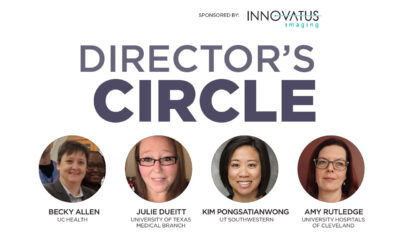
 In my first column on this subject I wrote about the five universal fears and how they get in the way of conflict resolution. The second column reviewed the need for good listening.
In my first column on this subject I wrote about the five universal fears and how they get in the way of conflict resolution. The second column reviewed the need for good listening.
The third installment explained the five steps for resolving conflict, which I call the Relationship Ladder. By way of review, the five steps of this ladder are:
- Focus on the other person
- Seek to learn if you understood
- Look for trust
- Gently discover the truth
- Establish hope
As a resource, you can see a video explaining the process on ICE magazine’s website.
In this final installment, I present some examples of the Relationship Ladder in use.
Example #1: JoAnn
“What’s wrong with you people?” Mr. Williams yelled into the phone. “You do nothing all day long. All I’m asking is that you do your jobs. Why can’t you process my simple request?”
As a supervisor, JoAnn was accustomed to brash confrontations. Mr. Williams was a senior manager, but he had made his request just that morning. Moreover, it was missing some vital information, and other work had been flagged as higher priority.
Mr. Williams had a reputation for losing his temper but getting on his bad side was not something JoAnn really wanted to do.
JoAnn realized this situation was an opportunity for her to use the Relationship Ladder. Step One of the ladder was to focus on Mr. Williams’ thoughts and feelings, and Step Two was to seek confirmation that what she perceived was correct. She also knew she had to avoid responding to his personal jabs.
JoAnn quickly reviewed what Williams had said:
- What’s wrong with you people? (Personal jab)
- You do nothing all day long. (Personal jab)
- All I’m asking is that you do your jobs. (Personal jab)
- Why can’t you get my simple request processed? (The real issue)
JoAnn opted to seek confirmation on both his feelings and his thoughts. “Mr. Williams, this sounds very important to you. To clarify, you’re wanting to know how far along your request is in our system?”
Mr. Williams was a little surprised. Usually someone took his bait for an argument. “Exactly,” he said. “Why don’t I have what I asked for?” He tried to sound gruff in his response, but JoAnn thought she could sense his voice tone drop a bit. JoAnn thought. Step Three is “Look for Trust.” Did she sense some there?
JoAnn decided to build more trust. Mr. Williams needed to know his concerns were important, so she told him she would look into the matter and call him back. Not only did that give her time to think through her response, it also gave time for Mr. Williams to cool down, knowing that JoAnn was working on his problem.
When JoAnn called him back 10 minutes later, she wanted to make sure trust had been established, so she restated her concern for his needs. When she could tell that he was feeling respected, she moved on to Step Four, Gently Discover the Truth. When she realized he wasn’t giving her any resistance, she segued into Step Five, Establishing Hope. It sounded like this:
“I see your request is related to the ADA project, and that it’s an important component of that project. In looking at our schedule today, our workload has quite a few jobs flagged as high priority, which you may not have been aware of. All our personnel are tied up on those jobs this morning, so it looks like we can get to your request this afternoon. However, while I have you on the phone, I have your request here in front of me, and I notice that some of the information is missing. Can I get that from you now, or would you rather I talk with someone else about it?
JoAnn knew this was a bold approach, but she also knew that no magical phrasing existed. She just needed to trust the process of using the Ladder.
As it turned out, Mr. Williams was impressed with JoAnn’s professionalism. He wasn’t thrilled to hear his paperwork had not been completed properly, but together they got everything worked out and his work request made it onto the schedule. Hope had been established.
Stick with the Five Steps
It’s difficult enough dealing with our own and other people’s emotions when resolving conflict, so having a step-by-step process such as the Relationship Ladder serves as a useful guide. Thankfully, JoAnn had practiced using the Ladder, or she might have responded to one of Mr. Williams’s personal jabs. If she had done that, the ripple effects would not have been good.
Dennis is someone else who had studied the Relationship Ladder.
Example #2: Dennis
As a middle manager attending one of my training classes, Dennis put the Ladder to work when a disgruntled employee barged into his office all fired up and ready for a verbal shouting match. Instead of pushing back, Dennis used the Relationship Ladder.
As the employee stood and ranted, Dennis listened. He paraphrased. He restated. He clarified. He calmly acknowledged, without judgment, all that the employee had to say, even though he didn’t agree with everything being said.
Before long, the employee was sitting down and the two were talking calmly. Then Dennis asked, “So, what would you like from me?” This was his way of Establishing Hope. As they wrapped up, Dennis said he would look into the situation, and the employee left Dennis’s office in a much better mood than when he entered.
Later, Dennis told me this same employee stopped him in the hall several weeks later. He expressed his gratitude to Dennis for the professional way in which he handled that emotionally charged situation.
These five steps don’t come naturally. You must make a conscious choice to do them. But the five steps, used in order, give you a proven plan for resolving conflict. Remember, conflict is inevitable, but unresolved conflicts demoralize a team. Therefore, you must resolve to resolve conflict, and the Relationship Ladder is a great tool for doing it.
Daniel Bobinski, M.Ed. is a best-selling author and a popular speaker at conferences and retreats. For more than 30 years he’s been working with teams and individuals (1:1 coaching) to help them achieve excellence. He was also teaching Emotional Intelligence since before it was a thing. Reach Daniel through his website, www.MyWorkplaceExcellence.com.








